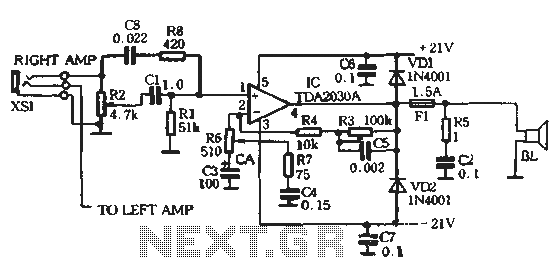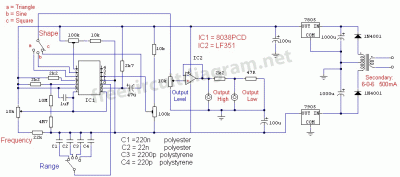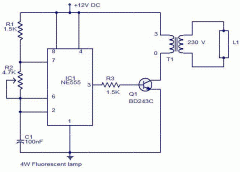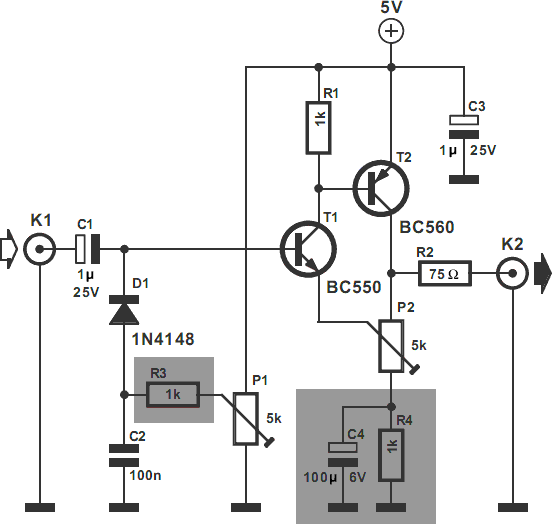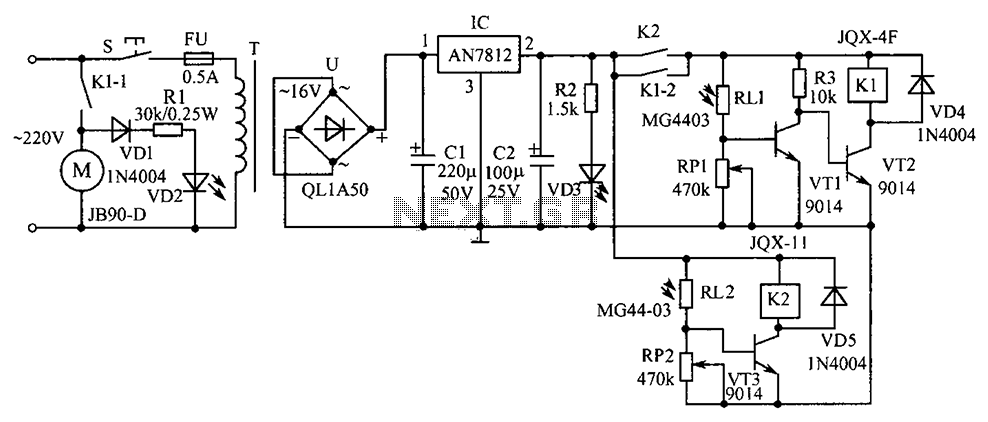
high gain antenna 43dB amplifier circuit
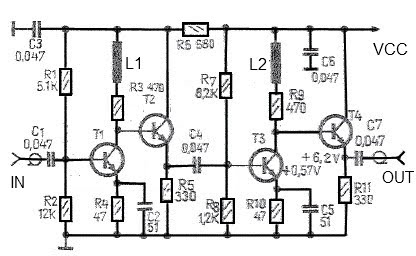
A simple and effective antenna amplifier can be built using the provided circuit diagram. This amplifier is designed for the frequency range of 35 kHz to 150 MHz. It utilizes transistors, offering a low non-linearity of 3 dB and a high gain of 43 dB. The input and output impedance of this RF amplifier is 75 ohms. The L1 and L2 radio frequency coils are made from 0.25 mm CuEm wire, with a diameter of 5 mm, each requiring 10 turns. All transistors used in the circuit are of the same type, such as BF183, BF200, or other similar types. The total power consumption of this RF amplifier is quite low, requiring only 20 mA.
This antenna amplifier circuit is particularly advantageous for enhancing weak signals in the specified frequency range, making it suitable for various radio applications. The choice of transistors, such as the BF183 or BF200, ensures reliable performance and compatibility within the circuit. These transistors are known for their low noise characteristics, which contribute to the overall effectiveness of the amplifier.
The design includes two inductors, L1 and L2, which are essential for tuning the amplifier to the desired frequency range. The specification of using 0.25 mm CuEm wire for the coils ensures minimal resistance and optimal inductance, while the 5 mm diameter allows for a compact design. The requirement of 10 turns for each coil is a critical design parameter that determines the inductance value, which is necessary for achieving the desired gain and frequency response.
With an input and output impedance of 75 ohms, this amplifier is well-suited for integration with standard RF systems, ensuring minimal signal reflection and maximum power transfer. The low power consumption of 20 mA makes this amplifier an energy-efficient choice, allowing it to be powered by battery-operated devices or low-power supply circuits.
Overall, this antenna amplifier circuit is an excellent solution for individuals seeking to improve signal reception in the specified frequency range, combining simplicity, efficiency, and effectiveness in its design.A very simple and useful antenna amplifier can be constructed using this circuit diagram. This antenna amplifier is very useful for 35kHz-150Mhz frequency band. This antenna amplifier circuit is based on transistors and has a low 3 dB non-linearity and a high gain of 43 dB. The input and output impedance for this rf amplifier is 75 ohms. The L 1 and L2 radio frequency coils are constructed from a 0. 25 mm CuEm wire, with a 5 mm diameter. Both coils require 10 number of turns. All used transistors are of the same type and can be BF183, BF200 or other similar type. The total consumption of this rf amplifier is very low, the circuit will need only 20 mA. 🔗 External reference
This antenna amplifier circuit is particularly advantageous for enhancing weak signals in the specified frequency range, making it suitable for various radio applications. The choice of transistors, such as the BF183 or BF200, ensures reliable performance and compatibility within the circuit. These transistors are known for their low noise characteristics, which contribute to the overall effectiveness of the amplifier.
The design includes two inductors, L1 and L2, which are essential for tuning the amplifier to the desired frequency range. The specification of using 0.25 mm CuEm wire for the coils ensures minimal resistance and optimal inductance, while the 5 mm diameter allows for a compact design. The requirement of 10 turns for each coil is a critical design parameter that determines the inductance value, which is necessary for achieving the desired gain and frequency response.
With an input and output impedance of 75 ohms, this amplifier is well-suited for integration with standard RF systems, ensuring minimal signal reflection and maximum power transfer. The low power consumption of 20 mA makes this amplifier an energy-efficient choice, allowing it to be powered by battery-operated devices or low-power supply circuits.
Overall, this antenna amplifier circuit is an excellent solution for individuals seeking to improve signal reception in the specified frequency range, combining simplicity, efficiency, and effectiveness in its design.A very simple and useful antenna amplifier can be constructed using this circuit diagram. This antenna amplifier is very useful for 35kHz-150Mhz frequency band. This antenna amplifier circuit is based on transistors and has a low 3 dB non-linearity and a high gain of 43 dB. The input and output impedance for this rf amplifier is 75 ohms. The L 1 and L2 radio frequency coils are constructed from a 0. 25 mm CuEm wire, with a 5 mm diameter. Both coils require 10 number of turns. All used transistors are of the same type and can be BF183, BF200 or other similar type. The total consumption of this rf amplifier is very low, the circuit will need only 20 mA. 🔗 External reference
